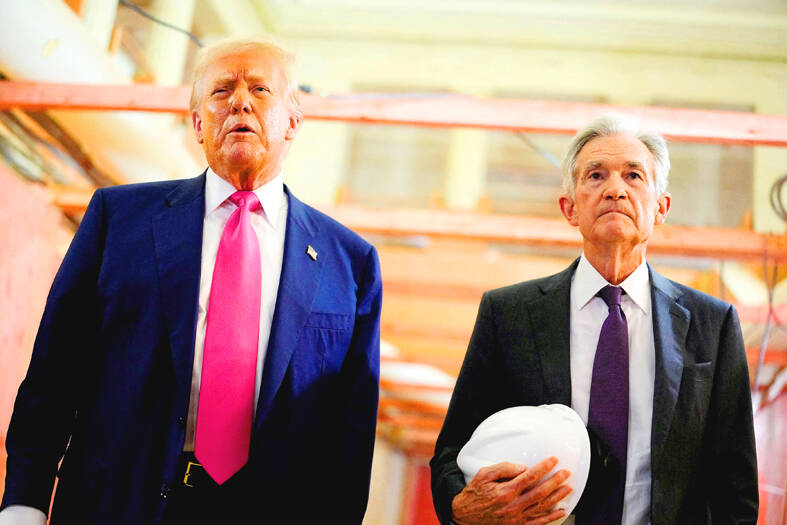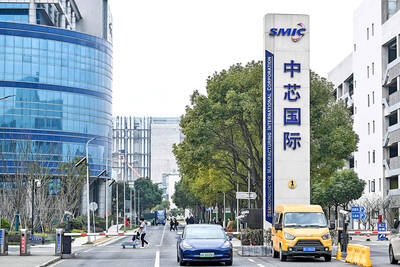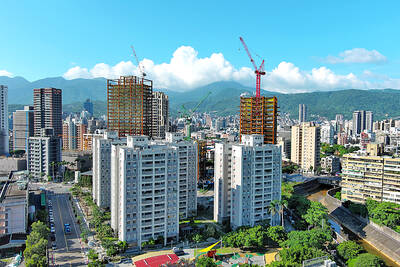US President Donald Trump suddenly has a chance to fill an opening at the US Federal Reserve earlier than expected, after Fed Governor Adriana Kugler announced her resignation on Friday.
It might also force him to pick the next Fed chair months sooner than he had anticipated.
“The ball is now in Trump’s court,” LH Meyer/Monetary Policy Analytics Inc economist Derek Tang said. “Trump is the one who’s been putting pressure on the Fed to do this and that, and Trump says he wants to have his own people on. So now he has the opportunity.”

Photo: Reuters
Kugler’s exit unfolds amid unprecedented public pressure from the White House on the central bank over monetary policy, with Trump regularly launching personal insults at Fed Chair Jerome Powell on social media. On Thursday, he called the Fed chief “TOO ANGRY, TOO STUPID, & TOO POLITICAL” for refusing once again — along with several other policymakers — to lower interest rates.
Kugler’s resignation creates an immediate opportunity for Trump to install an official at the Fed who can push for those lower rates, rather than having to wait until January when her term was due to expire to appoint a replacement.
Yet one more vote in Trump’s favor does not come close to ensuring a rate cut. Last week, the Federal Open Market Committee (FOMC) — the rate-setting panel that is comprised of seven governors and five of the regional reserve bank presidents — voted 9-2 to leave rates unchanged. The two dissenting votes came from a pair of officials appointed by Trump during his first term in office.
However, arguably more important than a solitary vote is that Kugler’s announcement might affect Trump’s timetable to choose the next central bank chair.
That is because, if he wants to pick an outsider to join the board — such as National Economic Council Director Kevin Hassett or former Fed governor Kevin Warsh — he might not get another chance soon.
Powell’s term as chair ends in May next year, but his underlying post as a governor extends into 2028. While it is typical that outgoing chairs also resign from the board, Powell has so far declined to reveal his plans. If he does not depart altogether, Trump would not get another opening on the board to fill before 2028.
Under that scenario, the US president might be forced to fill the Kugler opening with the person he intends to promote in May. If he is anxious to add a new loyalist to the board as soon as possible, he would have to decide soon who that chair would be.
“The key implication is that this is the one vacancy that President Trump has to work with,” said Tobin Marcus, head of US policy and politics at Wolfe Research. “So if he wants the next chair to come from outside the current Fed board of governors, we’ll see who that person is sooner rather than later.”
To others, the opening does not guarantee a quick move.
“If Trump knows who he wants to nominate as chair of the board, there’s no reason not to act now, but it’s not an action-forcing event,” said Adam Posen, president of the Peterson Institute for International Economics in Washington. “The board has functioned with fewer than seven members before, and the administration doesn’t seem to mind under-staffing essential positions.”
There has been no indication that Trump has made up his mind on the job. Hassett, Warsh, US Secretary of the Treasury Scott Bessent and Fed Governor Christopher Waller are all said to be contenders.
Whenever he makes a choice, that nominee would also require confirmation by the US Senate, a process that can take months before they are installed on the board.
“Even with this Republican Senate, it takes a bit of time to get somebody through the mill,” said David Wessel, director of the Hutchins Center on Fiscal and Monetary Policy at the Brookings Institution in Washington. “So it could drag out.”
Even after Trump installs a new chair, a successor to Powell would not guarantee any immediate change in policy at the Fed. Rates can only be adjusted by a majority vote of the FOMC.
Chairs are traditionally given substantial deference by FOMC members in their pleas for consensus when opinions on the committee divide, but that consensus would be difficult to achieve if the new chair cannot muster a convincing economic argument for cutting rates.
Last week was the first instance since 1993 that two governors voted against an FOMC decision.

NO BREAKTHROUGH? More substantial ‘deliverables,’ such as tariff reductions, would likely be saved for a meeting between Trump and Xi later this year, a trade expert said China launched two probes targeting the US semiconductor sector on Saturday ahead of talks between the two nations in Spain this week on trade, national security and the ownership of social media platform TikTok. China’s Ministry of Commerce announced an anti-dumping investigation into certain analog integrated circuits (ICs) imported from the US. The investigation is to target some commodity interface ICs and gate driver ICs, which are commonly made by US companies such as Texas Instruments Inc and ON Semiconductor Corp. The ministry also announced an anti-discrimination probe into US measures against China’s chip sector. US measures such as export curbs and tariffs

The US on Friday penalized two Chinese firms that acquired US chipmaking equipment for China’s top chipmaker, Semiconductor Manufacturing International Corp (SMIC, 中芯國際), including them among 32 entities that were added to the US Department of Commerce’s restricted trade list, a US government posting showed. Twenty-three of the 32 are in China. GMC Semiconductor Technology (Wuxi) Co (吉姆西半導體科技) and Jicun Semiconductor Technology (Shanghai) Co (吉存半導體科技) were placed on the list, formally known as the Entity List, for acquiring equipment for SMIC Northern Integrated Circuit Manufacturing (Beijing) Corp (中芯北方積體電路) and Semiconductor Manufacturing International (Beijing) Corp (中芯北京), the US Federal Register posting said. The

India’s ban of online money-based games could drive addicts to unregulated apps and offshore platforms that pose new financial and social risks, fantasy-sports gaming experts say. Indian Prime Minister Narendra Modi’s government banned real-money online games late last month, citing financial losses and addiction, leading to a shutdown of many apps offering paid fantasy cricket, rummy and poker games. “Many will move to offshore platforms, because of the addictive nature — they will find alternate means to get that dopamine hit,” said Viren Hemrajani, a Mumbai-based fantasy cricket analyst. “It [also] leads to fraud and scams, because everything is now

MORTGAGE WORRIES: About 34% of respondents to a survey said they would approach multiple lenders to pay for a home, while 29.2% said they would ask family for help New housing projects in Taiwan’s six special municipalities, as well as Hsinchu city and county, are projected to total NT$710.65 billion (US$23.61 billion) in the upcoming fall sales season, a record 30 percent decrease from a year earlier, as tighter mortgage rules prompt developers to pull back, property listing platform 591.com (591新建案) said yesterday. The number of projects has also fallen to 312, a more than 20 percent decrease year-on-year, underscoring weakening sentiment and momentum amid lingering policy and financing headwinds. New Taipei City and Taoyuan bucked the downturn in project value, while Taipei, Hsinchu city and county, Taichung, Tainan and Kaohsiung